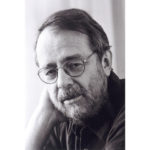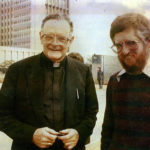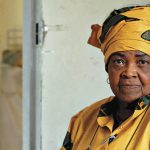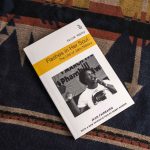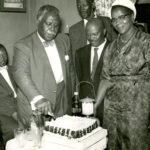Long Read | Neil Aggett, man of the people
Neil Aggett died in detention on this day in 1982. His death became a significant political event galvanising mass protest and new forms of trade union unity in action.
Author:
5 February 2019

Neil Aggett, a medical doctor and organiser with the Food and Canning Workers’ Union, died while in detention at the John Vorster Square police station (now the Johannesburg Central Police Station) on 5 February 1982. On 11 February trade unions united in a combined general stayaway in protest at his death. Two days later his funeral was attended by 15 000 people.
In this edited extract of her acclaimed biography, Death of an Idealist: In Search of Neil Aggett, Beverley Naidoo offers an account of his funeral. Her biography was first published by Jonathan Ball in 2012.
The Aggetts set off early. They had received permission to visit Neil’s partner Liz Floyd in Johannesburg General Hospital’s psychiatric wing before the funeral. The security police had no intention of letting her photograph be displayed across the world and had turned down her request to attend. An armed guard stood outside the door to her room, while a policewoman remained inside throughout the visit. Neil’s sister, Jill, recalls her shock at seeing Liz:
“She was very pale and spaced out, completely shattered. She said at the time, ‘I can barely remember my name.’ She was mentally drained, emptied. ‘I can’t add or do anything. My mind has gone.’”
The last time they had met, about six months earlier, Jill and husband Paul had come to Johannesburg with the children, meeting Liz and Neil in Kensington’s Rhodes Park so the children could play while they talked. Afterwards, invited to 420a Fox Street for a meal, they had bathed the children there, preparing them for bed. It was a simple family get-together, almost normal, except that it was a rare event.
Joy and Aubrey, Neil’s parents, however, knew Liz even less, and on the few occasions when they had met, they had always been wary. They associated her with Neil’s diversion from the conventional career path they’d imagined for him. Nevertheless, seeing her present state was disturbing. To Aubrey, she was “in a helluva mess”, while Joy recalled Neil’s brother, Michael, saying “a little prayer”.
Arrival
The church service at St Mary’s was due to begin at 11.30am. When the family arrived, roads around the cathedral had been blocked off and were being monitored by the security police. Paul drove a bright yellow Cortina station wagon, with Aubrey in the front beside him. Jill, Joy and her sister, Madge, were squeezed in the back. Michael crouched in the boot. Since they were due to follow the hearse, the car was allowed through the cordon and permitted to park. Already it was a hot highveld day as they struggled to make their way through the singing, chanting crowd waiting around the building.
Inside the cathedral, in strong contrast to the usual sombre quiet of an English church prior to a funeral service, lilting emotional voices in mass harmony were paying tribute to Neil. They were singing the union songs he had loved, interspersed with pained, angry cries of ‘Amandla! Ngawethu!’ Seats had been reserved for the family in the front row of the nave. Designed to seat 1 400, the cathedral was overflowing. Pews were packed and mourners stood in aisles or wherever they could squeeze in. From the organ loft, organist Richard Cock could see people sitting on top of the covered doorways of the porch, inside the side door of the cathedral.
In the congregation were the families of other detainees who knew that the Aggetts’ loss could so easily be their own. While Jill knew people from Detainee Parents’ Support Committee meetings, for her parents only a handful of relatives and the white uniforms of 200 or so nurses could provide any note of familiarity in this vast assembly.
Related article:
The nurses had arrived in procession from Baragwanath hospital, ululating and singing as they had made their way into the central area of the nave and the upstairs gallery, alongside hundreds of workers, many in union T-shirts. In among the mourners, foreign and local camera crews and reporters had positioned themselves around the cathedral.
The simple pine coffin lay in the apse, carried in by union pallbearers some 15 minutes before the service was due to begin. Sprays of red and white carnations partially covered the large white letters of FCWU (Food and Canning Workers Union) and AFCWU (African Food and Canning Workers Union) on the union’s red flag, on either side of its central circle of clasped black hands. Dozens of yellow chrysanthemum plants and burning candles surrounded the coffin, auguring a service that would be infused with the social and political world Neil had embraced. This was to be a funeral not simply to mourn but to raise spirits for the ongoing struggle.
_0.jpg)
The union had printed a funeral programme, a single sheet folded into four pages, with a black and white picture of Neil on the front, his beard and moustache a little trimmer than in his final family photograph. The portrait was ensconced between two captions: “Died in detention 5.2.1982” above, and the union’s motto, “An injury to one is an injury to all”, below.
On the back page were the words of Nkosi Sikelel’ iAfrika, unknown to most white South Africans at that time. Inside, a tribute was followed by an outline of proceedings, divided into stages: Church Service, Funeral Procession, Burial Service and Tributes and Messages. There was also a note about transport arrangements between the cathedral and West Park Cemetery, about nine kilometres away through northwestern “white” suburbs. Black mourners would also require help getting back to Park Station, from where they had to travel to their townships to be out of the city by night. Whatever Neil had done to challenge apartheid during his life, he could not avoid being buried in a whites-only cemetery.
Related article:
A second handout, a service sheet from the Cathedral Church of Saint Mary the Virgin, Johannesburg, with the words of the hymns, songs and prayers, reflected an interweaving of Anglican and African traditions: Umzima lomthwalo/Ufuna sihlangane (The load is heavy/It needs us to come together) coming between The Lord is my Shepherd and Guide Me, O Thou Great Redeemer; the measured tones of O God, Our Help in Ages Past giving way to the farewell and promise to meet again in Hamba kahle sihlobo sethu (Go well, our brother), to be sung while the coffin was carried from the cathedral.
But the neatly printed sheets give little clue to the overwhelming emotion inside the building. Tasked with bringing the vigorous impromptu singing to a close, Cock played a piece by the 19th century composer Thomas Walmisley, which opened very loudly and ended softly. The mourners responded, allowing the service to begin with Psalm 23.
The tributes
General secretary of the FCWU Jan Theron’s tribute to Neil, given on behalf of the union, preceded both the scripture reading and the Dean’s sermon. Activist Sipho Kubeka stood beside him, translating. Gaunt and tall in front of his comrade’s coffin, Jan expressed sympathy with the family before speaking passionately, at times tearfully, of Neil’s work towards the unity of all workers and thereby his contribution to the country: “When they speak of suicide, we say he was killed. We put the blame where it lies, with the government of the country and with the security police who do its dirty work for it.”
Joseph Lelyveld, reporting for The New York Times, noted that “The union leader … sounded tense and angry. But when his words were translated into Zulu for the mainly black congregation of about 2 000 that filled the cathedral, they came across as warm and expressive.”
While Jan spoke as someone who had lost a younger comrade, Sipho spoke as one who had also lost a brother. Countering the hints in pro-government newspapers that Neil was an ANC operative and that he was to have been a state witness in a major political trial, Jan lambasted the regime’s claims that it was ready to accept free trade unions. Instead, in its attempts to discredit militant unions as being manipulated by the underground, the government was preparing for a show trial against trade unions, a trial in which comrades would be pushed to give evidence against one another. Jan’s tribute lasted almost half an hour, ending with a raised-fist cry of “Amandla!” The response from mourners rose to the vaults.
Related article:
Dean Simeon Nkoane’s subsequent sermon lauded Neil’s commitment to the principle of a just society. The Dean reminded the congregation about “all our brothers in detention. It is my hope that many South Africans will today make the decision that will change the kind of life we live in this country.”
For those who knew Neil well, the music that reminded them most vividly of the life extinguished was Abdullah Ibrahim’s Mannenberg, Liz’s special request. Quintessential South African jazz, it was Neil’s favourite. Friends remembered how Neil would keep Mannenberg playing at parties by sneaking the needle back to the beginning. Unrecorded on the cathedral’s programme, it was inserted before the final isiZulu hymn, Hamba kahle sihlobo sethu.
Related article:
In the carefully planned relay of carrying out the coffin, with Aubrey barely able to stand, Paul and Michael represented the family. Neil’s friend Yvette Breytenbach recalls being overwhelmed when it came to her turn:
“The atmosphere was so powerful, filled with beautiful, loud, strong African singing. The singing just filled the space and went through one. The coffin was so heavy. Neil was so heavy. I really had to use all my strength to carry my bit. When I had handed over I kept walking after it for a few paces in a daze.”
A friendly hand helped to steady her.
A flag unfurls
As the coffin emerged from the door of the cathedral, the crowd outside surged forward, singing Aggett wethu/Somlandela noma siyabosha (Our Aggett/We shall follow even if we are being imprisoned). A hand-held camera captured glimpses of the coffin’s progress as church officials and pallbearers made their way slowly towards the hearse. Within seconds of the coffin’s appearance, two striking ANC flags were unfurled above the crush of bodies, the black, green and gold in full view of the security police perched on the fourth and fifth floors of the block of flats across the road.
This was what Jan and those who had prevailed in the fierce debate on the committee had hoped wouldn’t happen. Steven Friedman would later write about workers who chose not to challenge the ANC activists for fear of prompting an incident and detracting from the focus of the day. He added that the “hijacking” would become a source of tension, as some unionists charged that the ANC had claimed as their own someone who, while sympathetic, had carefully avoided them:
“The flag was only part of the problem: workers wanted to know whose leader Neil was anyway: who had he died for?” said a unionist. “I guess this is the only kind of meeting these people are allowed, so they feel they ought to make the most of it,” mused another. As tensions between unions and black political groups grew, unionists cited the funeral incident repeatedly.
Related article:
However, many workers were clearly jubilant at this display of defiance by the banned ANC. What wasn’t in doubt was workers’ anger and militancy. For his American readers, Lelyveld described the procession as “a startling sight” and “the largest display of black political feeling” that had been seen in white areas since the Congress movement had been forced to go underground.
A printed sheet also appeared outside the cathedral, with the words of seven songs honouring Neil as one in a line of heroes fighting for freedom, including,
Kubi kubi Siyaya, siyaya, siyaya
Noma kubi
Kwashu Sisulu Siyaya Siyaya
Kwashu Neil Aggett Siyaya Siyaya
Kwashu Mandela Siyaya Siyaya
Noma kubi.
[In trials and tribulations we are marching on, we are marching on
Despite trials and tribulations
Sisulu said we are marching on
Neil Aggett said we are marching on
Mandela said we are marching on
Despite trials and tribulations]
Often sung and adapted, especially by ANC-aligned workers at meetings, these were songs that Neil had loved. Although unattributed, the source of the songsheet was almost certainly the same ANC activists behind the unfurling of the flag. Its version of Unzima lomthwalo reflected a far deeper militancy than that on the cathedral programme, including the lines:
Ayangena ayaphuma ayadidizela
Ayasaba amagwala (amaBhunu)
Wenagw’ ebaleka
Ayasaba amagwala (amaBhunu)
[They are joining, they are pulling out, they are confused
The cowards (Boers) are scared
They are running away
The cowards (Boers) are scared]
While not understanding the meaning of the words being sung openly and jubilantly on the streets of Johannesburg, the family could feel the revolutionary tone. Sitting inside the yellow Cortina, behind the hearse, in the midst of a “huge sea of people” on this “baking, baking hot day”, they waited for at least half an hour before the procession began to move, on foot, in buses and in cars. From inside their stiflingly hot car, the journey felt painfully slow, moving at the pace of the jogging, marching crowd around them.
All the way to the cemetery, Jill was aware of police “sharpshooters” on top of office blocks and along the road. At one point, police tried to stop the funeral procession, “squatting down in the road, pointing guns at us and everyone there. Eventually they got out of the way and let the cortege move on.” Inside the family car, everything felt unreal.
The cortege
The atmosphere outside was very different. The same hand-held camera that captured the raising of the ANC flag was now embedded in the surge of mourners, recording the journey to the graveside. Directed by Mark Newman, the remarkable film sweeps the viewer forward to the rhythm of stamping feet, singing and chanting as the procession makes its way through downtown Johannesburg and into the white suburbs. Workers hang out of buses, wave posters, fling out pamphlets, wave hats, raise branches and clench fists, while feet race forward. In the midst of the marchers, a wheelchair spins in full flow with the determined energy of the vast mass.
Newman was recording history in the making. He chose to do so from the viewpoint of the workers, who, in coming to honour Neil, were voicing their commitment to continue the struggle for which he had died. We see bemusement and shock on the faces of white residents. A group of children, torsos dripping from their swimming pool, scurry over a wall to see what is happening. Bafflement and uncertainty vie with their excitement. Two black policemen glance at each other as if they too cannot believe what they are seeing. Their astonished open mouths seem to hover on the brink of smiles.

At the cemetery
West Park Cemetery had never seen a funeral like this. Newman catches a swathe of mourners entering the high stone gateway on foot. Beyond the entrance, they spread out through the extensive, sprawling cemetery reserved for Johannesburg’s white deceased. They seem anxious to cover the remaining kilometre or two as quickly as possible.
Something that was not caught on Newman’s film occurred earlier, when those in the front of the procession reached the entrance and stopped the hearse. From inside the car, the family saw the coffin lifted out and raised aloft. From here, volunteer pallbearers carried their comrade under the banner of his union for this final journey. The open grave was waiting beneath a jacaranda tree, with the Melville Koppies in view. The Koppies had been a favourite place for Neil’s closest friend Gavin Andersson to come with Neil to sit and talk:
“In the winter you can find spots where the wind does not reach, the sun holds sway. And you can watch back down to the bottom of the path and see that nobody is following you. It’s a lovely place to talk. You can curl up in the sun for hours.”
A bench had been placed alongside the grave for the family. A photograph catches them sitting in front of a throng of people and union banners. Their shoes on the red earth are almost within touching distance of Neil’s coffin, poised on struts above the dark hole beneath. Aubrey’s head is bowed, and all their eyes are averted to the right, as if unable to bear the sight in front of them.
Related article:
Another image, taken by a photographer perched in the tree above, reveals that they are also turning aside from a multitude of cameras on the other side of the coffin. Bishop Hugh Stevenson stands surrounded by mourners to the family’s right, prayer book in one hand and funeral programme in the other. The tilt of the family’s heads suggests that they are waiting for him to speak, for this private, public agony to be over. This could be the moment before the committal.
Three young men, crouched on the ground, also wait. One stretches out his hand to touch the teak beading. Another clasps his knees, eyes fixed on the coffin, as if in silent conversation. White and black, they are a reflection of the wider crowd.
Among the quieter, poignant moments in Newman’s film is the reciting of the Lord’s Prayer as the coffin is lowered. The camera focuses briefly on the family and closes in on Joy’s anguished face. The family left soon after the service, not waiting for the reading of tributes and messages. Exhausted and anxious to get away from the crowds after a gruelling day, they didn’t manage to escape the press. Jill recalls being asked “stupid questions despite us all being clearly in distress – and then everything appears in the papers the next day”.
Underneath the jacaranda tree, a group of comrades filled the grave, red dust rising as their spades hit the earth, while others rapidly erected a small stage with microphone and speakers. Photographs of the vast assembly show a few umbrellas, hats and even posters used to cover heads, but most mourners stood or sat on the grass, brows furrowed and intense, unprotected from the sun. Yvette found herself so far away that she was unable to get anywhere near the grave to witness the lowering of Neil’s coffin. She was even too far off to hear the words spoken.
Honouring his sacrifice
Speeches made on behalf of Fosatu, the General and Allied Workers’ Union and the General Workers’ Union, and later published, pointedly called for solidarity and unity. Dave Lewis, general secretary of the General Workers’ Union, exhorted workers to end the factionalism dividing them. That had been Neil’s work, he said, and should be his legacy:
“Neil’s vision wasn’t just with the Food and Canning Workers’ Union, with the workers that he organised. Neil saw all workers … I think Neil’s death is a great price to pay for the unity of the union movement, but I think that the trade unions must see now clearly who the common enemy is. We must take the example that the workers showed on Thursday. And we must take the example of this funeral, and I think we must start to think about uniting the trade union movement. And that must be the monument that we must build to Neil Aggett. We don’t want a big building on a hill. The monument we must build to Neil must be the unity of the trade union movement.”
Lewis included a more personal note, although never diverting from his political focus. Workers would mourn Neil, he said, by taking forward his work, but they would also remember his personal qualities:
“We will also remember Neil as a kind, gentle person – that is what we will remember. Neil as a democrat who never wanted personal glory … and I think we should remember Neil in the words that a great comrade of Neil’s used to describe him as. Comrade Oscar Mpetha, who is one of the great leaders of the South African people … said of Neil, he said a very short and simple thing about Neil, he said that Neil was a ‘man of the people’ and there’s no greater thing that can be said about anybody.”
Related article:
Mpetha had managed to send two messages from his prison cell:
“To the family of Neil Aggett: I received with great horror the news of what happened to Comrade Neil, and we all grieved at this. Neil was a man of the people and not only the whites but the African people grieve with you.
To the meeting: It is a pity that I am under these government controls and I cannot be at the meeting. I assure you I am with you in spirit. Forward with the struggle.”
The emotion Oscar permits himself in addressing the family is harnessed to explain Neil’s significance. In contrast, his message to his union comrades is understated and businesslike. Yet the death of the young man he had mentored must have surely hit the old man hard.
Most of the tributes to Neil came from organisations representing workers, students and women across the country, too many for all to be read out, especially as speeches were also being translated into isiZulu. A telegram from the International Confederation of Free Trade Unions stated that it had called for an inquiry and the release of all trade union detainees. A telegram from Archbishop Denis Hurley, president of the Southern African Bishops’ Conference, deplored “cruel inhuman conditions’” and called for the end of detention without trial: “Praying to God Neil would not have died in vain and that the trade unions movement will go from strength to strength.”
There was a message, too, from Neil’s old school. Eschewing political content, it spoke more personally:
“The head, staff and pupils of Kingswood College, Grahamstown, remember with pride and affection the life of one of its promising old boys. Our prayers are with you today, and our sympathy extends to all those near and dear to Dr Aggett.”
Related article:
Perhaps the hardest task on the podium that day fell to Sipho, in reading the tribute sent by Gavin. Intimate emotion throbbed beneath the words that were yoked into their shared struggle. It was up to them to realise “the ideals and the cause” for which their fallen brother had worked so hard:
“Our brother, Neil Aggett, has been killed in detention. Though he is not the first brave person to die at the hands of the security police, this fact does not make his death any the more acceptable. All of us who knew and loved Neil will forever grieve for this gentle and considerate man. We will remember his warmth and keen sense of humour, his calm strength and fairness, his deep commitment to people and to building democratic organisations. It is difficult to accept that we have been robbed of his presence for always.
“But in the middle of this terrible moment, when we stop to mourn the loss of such a wonderful person, let us also rejoice that in the end he has been victorious over his persecutors, over his killers. Because the ideals and the cause for which Neil Aggett worked so hard, these didn’t die on the 5th of February. They live more strongly than ever in all of us, run deep through millions of hearts, and will find expression one day in a song that will break down the walls of the prisons, a song that will be heard all around the world and through all the centuries.
“Neil’s death serves us notice that it is now time. It is now time for all democrats, all lovers of freedom and of peace, to unite, to work together, to surge forward in a determined and unstoppable wave, sweeping away forever all traces of this oppressive regime, and to build a new South Africa, a South Africa which is worthy of sacrifices by such brave martyrs.
“May Neil’s death bring focus to our resolve. His life will be a shining example through the hard years that lie ahead. Go well, dear brother, sweet friend, true comrade.”
Related article:
In mourning their brother, friend and comrade, Gavin and Sipho dealt with their own grief by turning a terrible loss into a victory. Neil’s persecutors and the oppressive state would be defeated by Neil’s death spurring on “all democrats, all lovers of freedom and of peace, to unite … and to build a new South Africa”. Neil was now a martyr to the cause and his death a sacrifice that should not be in vain. Its political meaning had to take precedence over the personal. Years later, when I asked Sipho about the funeral, he responded that I was “going into an area which is not pleasant for me” and only hinted at a personal sense of loss by mentioning that he and his wife had named their youngest son Sicelo Neil. It was more important to Sipho to outline its wider political meaning:
“The funeral was the first of its kind in Joburg because it was held in the city centre … It unified many organisations. It brought people from the townships who were ordinary workers, members of unions. And I must say, as we were going towards the cemetery, Joburg was completely liberated that day. So the massiveness of the people there transformed Joburg that day – and Joburg as Joburg came to a standstill.”
For Neil’s comrades, his funeral would be remembered as a transforming moment. In contrast, his family struggled to find any meaning in his death.

